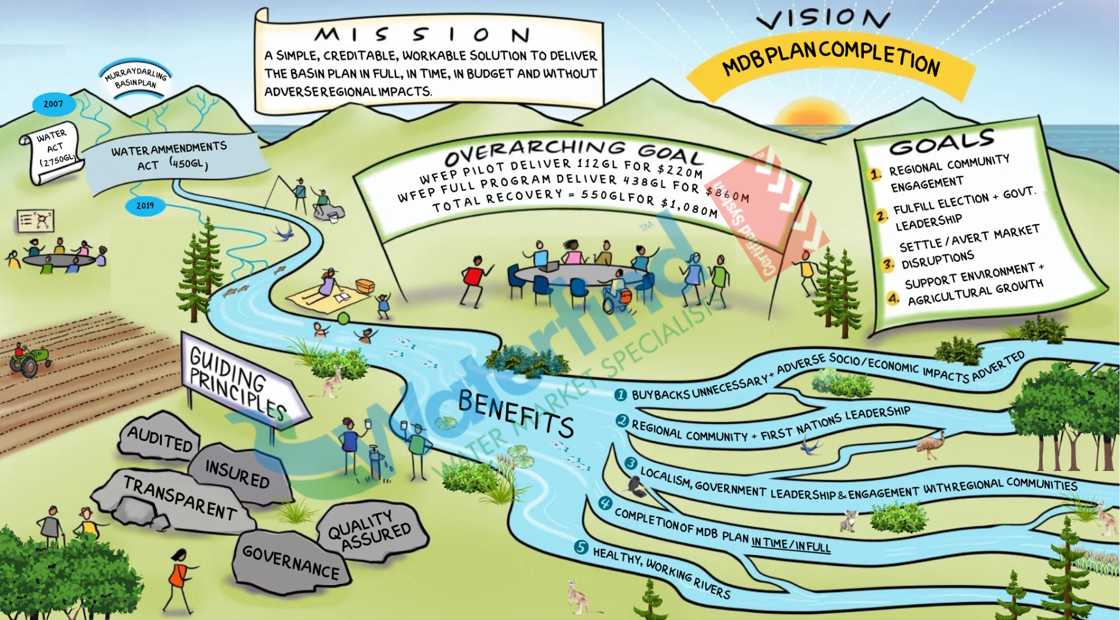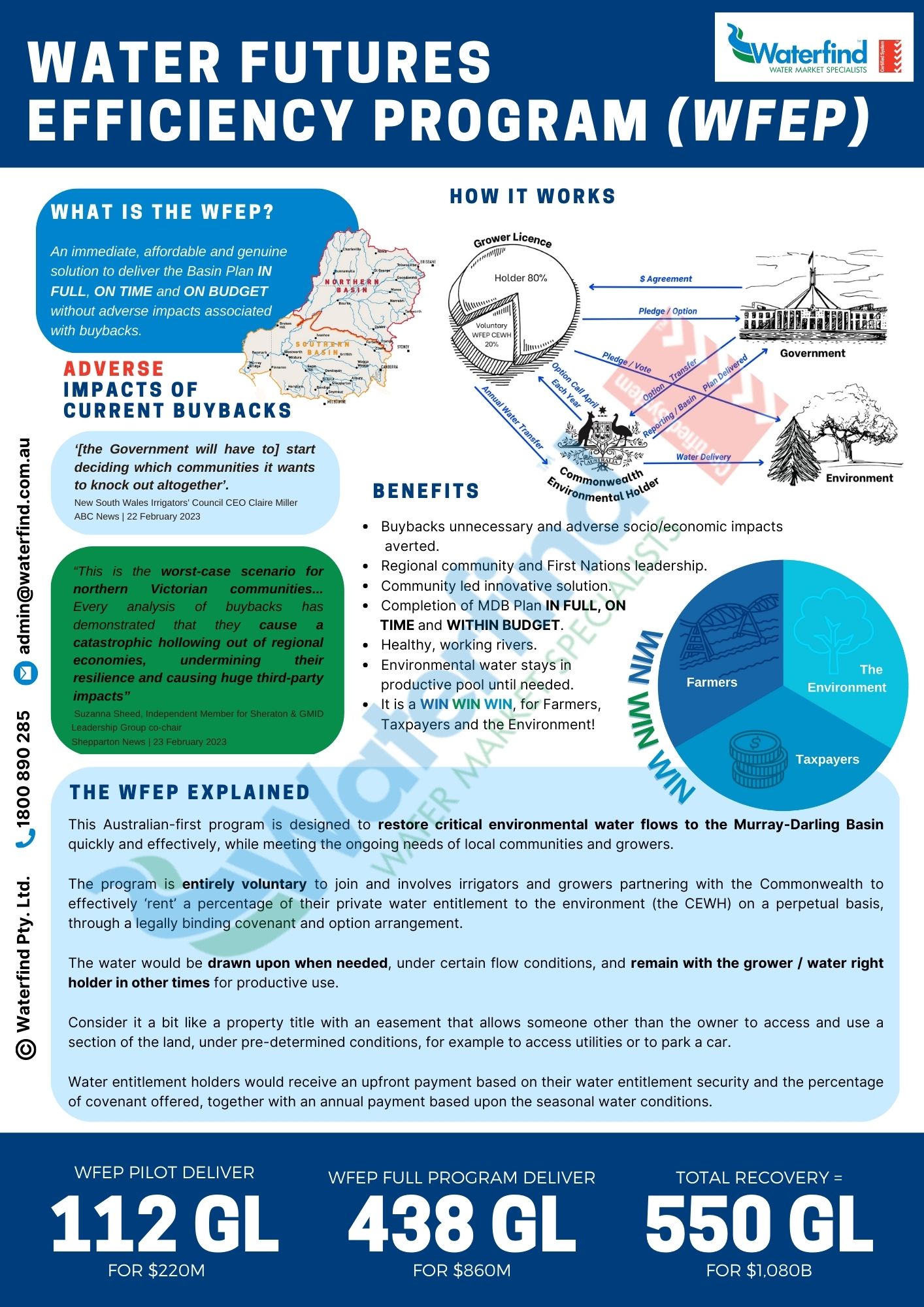
Menu
- Home
- Products
- Services
- News And Resources
- About Us
- Ask an Expert
- Contact
- Search
- Restoring Our Rivers 2024 - Expressions of Interest

An Australian-first program designed to restore critical environmental water flows to the Murray-Darling Basin, while meeting the ongoing needs of local irrigators and growers, has been proposed by Waterfind Pty Ltd as an ‘immediate, affordable and genuine’ solution to the nation’s Basin Plan – avoiding the need for buybacks as announced by the Federal Government.
The voluntary scheme would allow irrigators and farmers to commit voluntarily, under a robust legal framework, to effectively ‘rent’ a percentage of their water entitlement to the environment when needed through a water ‘covenant’. When the water is not needed, the grower would retain their full water allocation for productive use.
While the program has been proposed by Waterfind through the Commonwealth Budget submission process, the program has not yet been funded or endorsed by Governments (either Federal or State).
Waterfind is now seeking feedback from Australian Water Right holders which it intends to use as part of our ongoing efforts to encourage the Commonwealth and/or Basin States to trial a pilot in a timeframe that enables the potential success of the pilot to be expanded to deliver the balance of our urgent water recovery targets.

To date,
most of the Murray-Darling Basin Plan’s water goals have been achieved through
buy backs which have been now independently verified to create adverse regional
socio-economic impacts and meddle with the operation and value of the national
water market.
On/off-farm
water efficiency projects have contributed the second-highest volumes, which
have been reported to support local communities and irrigators as they
encourage more ‘crop per drop’. They also provide a range of economic benefits
and jobs in the regions associated with engineering and construction.
However,
progress on water efficiency projects has been slower than expected, which is
being compounded by the inherent complexities associated with large-scale
infrastructure projects – including long lag times, supply chain constraints
and rising costs.
As the July
2024 deadline looms to finish the environmental water required under the Murray-Darling
Basin Plan, it has now been conceded by Government that the existing plan to
recover this shortfall through efficiency projects will not be
achieved in full and on time and that the Federal Government will have no
choice but to consider other ways to make up the shortfall.
This WFEP
Program offers an immediate, affordable and genuine solution to make up the
shortfall without any adverse impact on local growers or their communities.
Irrigators
and growers who choose to be part of the program would get the benefit of both
an upfront and annual income payment, while being able to make productive use
of the environmental water when it’s not needed by the Commonwealth.
Additionally,
the program will enable growers to vote their annual water covenant to the best
local environmental watering projects within their catchment and enable them to
further engage with these projects together with other local community and
First Nations peoples.
No. The Water Futures Efficiency Program is a proposal that has been made to the Government to fund as an alternative to other measures, which will have alarmingly detrimental impacts to our regional communities.
The Government has not yet funded the WFEP and Waterfind has independently created and self-funded the WFEP solution. It is an entirely voluntary scheme for irrigators, growers and the Basin community, that is offered as an alternate option to the current buyback process to participate in. The WFEP pilot is currently with the Commonwealth and the State Governments for support consideration.The program
framework includes a range of water sharing options or covenants, which have
been designed to maximise
the support and involvement from different grower groups.
As such,
each of the four products create a covenant over a different section of a
grower’s water entitlement (ie first, last or equal sharing) and are activated
under different water flow and allocation conditions. While it is the grower’s choice about which
product to activate, it would be envisaged that a rice grower would choose a
different product than say a citrus grower and the program has been designed to
enable this flexibility.
As such the
program will deliver water under a range of climatic conditions, also providing
the Commonwealth Environmental Water Holder with an ability to support diverse
deliveries and outcomes under drought, normal or wet catchment conditions.
Environmental
Water demand varies from season to season and catchment by catchment, which can
experience drought, normal or wet conditions. During wet conditions (eg, excess
water flows), under the WEFP program, it would be most likely that the CEWH
would not call upon the water delivery, as such they would have no need to
access/or disrupt the market, and water can be used by the grower and/or be
carried through to a future season for use by the grower.
The program utilises existing state water titling and common/contract law provisions to create and register the covenant and, as such, does not require any legislative change to create the product. A determination or definition needs to be established, however, if the WFEP will meet the requirements of the long-term water adjustments required by legislation under the Basin Plan, Waterfind proposes that this could be a simple policy determination rather than a legislative change, but ultimately this would be a decision of the government.
A blunt, rapid
approach to buybacks would have potentially devastating socio-economic
consequences across our regions. An
escalated recovery through buybacks of up to 1 million ML of raw entitlement
may be required to achieve the long-term cap equivalent shortfall of the water
recovery targets.
A water recovery
target of this magnitude is far greater than the normal market liquidity
(quantity of trade in the permanent market per annum) and, as such, would
either require the government to conduct this purchase over a long run
timeframe (10 or 20 years) or dramatically increase the price to, in essence,
‘bring forward’ future years market liquidity to today.
While dramatic inflationary shocks would be welcomed by retiring farmers, it would leave unknown substantial consequences to those farmers who remain as well as new farmers entering the sector. This is because the value of water would quickly reach an amount which would make farming unviable, exhausting this most important industry from our regional communities and national food security.
A lot less!
A recent Federal Government report (Water for the Environment Special
Account (WESA) report, tabled in August last year) found the ‘estimated
cost to recover the full 450 GL through efficiency measures is between $3.4
billion and $10.8 billion.’
Waterfind
has estimated that upfront costs alone could be as much as $6.5 billion (for
buy-backs) and as much as $21.8 billion (for off-farm water efficiency
measures).
By
contrast, this Program would be just a fraction of that cost at an estimated
$220 million for a pilot or $1.2billion if water was recovered through this
measure for 100% of the potential water shortfall – this represents significant
savings for taxpayers.
It is
estimated the Pilot would run for approximately 6 months and deliver approximately
112 GL of water, with the program proposed to be managed by accredited and
vetted Commonwealth delivery partners.
If
successful, it’s anticipated a broader program would then be rolled-out for a
further 12 months to achieve the full Basin Plan’s recovery target.
Yes. The
program promotes environmental projects led by regional communities and
employment and leadership opportunities for First Nations peoples. First nations cultural water projects would
be encouraged to be part of the CEWH mix of projects on offer for local water
right holders to set as a preference for watering delivery.
The core
premise of this Program is to find an immediate, affordable and genuine
solution to the Murray-Darling Basin Plan’s water recovery targets that strikes
the right balance between the environmental and the ongoing economic needs of
Basin communities.
We are a
proud Australian-owned and operated family business. As the nation’s leading
water market specialist, we have a long history of delivering environmental
water and have a client base representing two thirds of all water entitlements
in Australia.
We stand
shoulder-to-shoulder with growers because, like them and thousands of other
businesses right across Basin communities, we rely on a sustainable
Murray-Darling Basin for our future.
By
designing, developing and self-funding this Program, we are not only
contributing to what we see as the future prosperity of the environment, but to
the Murray Darling Basin and all the growers who rely on it.
We would,
of course, be delighted to be considered as a Delivery Partner to administer
the pilot and broader program just as we have done successfully with other
Commonwealth projects or programs in the past.
We
respectfully encourage the Government to consider this Program as an
affordable, immediate and genuine solution to achieving the Murray-Darling
Basin Plan’s water shortfalls. The pilot
can get underway very quickly. We suggest a pilot region be used to test the
uptake of the various water options and to refine pricing of these options.
Following
the conclusion of this pilot, and potentially other pilots, the broader Program
can be implemented in a timely manner which we believe can achieve the Basin
Plan Water requirements on time and in full.